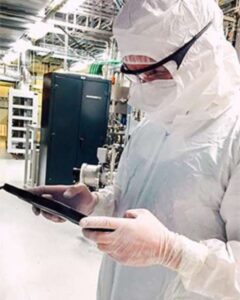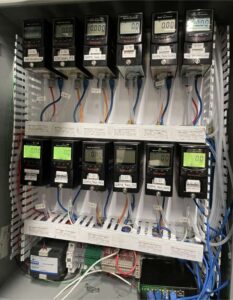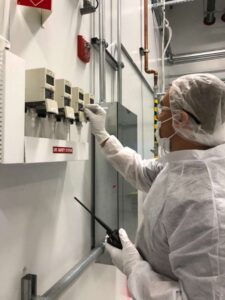Industry Experience
At MDC Systems, we have extensive experience working with various industries that require gas detection and safety systems. Our solutions are tailored to ensure the highest levels of protection when dealing with hazardous gases, including flammable, toxic, and asphyxiating substances. Below is an overview of the industries we serve, along with the types of applications and gases commonly involved.
Semiconductor Manufacturing
Semiconductor manufacturing involves the use of highly toxic and flammable gases. Key materials such as phosphorus, arsenic, boron, and gallium are used as doping agents, while hydrogen serves as both a reactant and reducing atmosphere. Etching and cleaning gases like HCl, Cl2, and NF3 are also common in this sector.
Typical Applications:
- Wafer reactors
- Wafer dryers
- Gas cabinets
- Chemical vapor deposition (CVD)
Common Gases:
- Flammable: Hydrogen, Isopropyl Alcohol, Methane
- Toxic: HCl, AsH3, BCl3, PH3, CO, Cl2, HF, O3, H2Cl2Si, TEOS, C4F6, C5F8, GeH4, NH3, NO2, O2
- Deficiency: Nitrogen
- Pyrophoric: Silane
Solar Manufacturing
The solar manufacturing industry uses various materials processed with hazardous gases. Doping agents like phosphorus and arsenic, along with etching gases such as HCl and NH3, are commonly used. Research and development in solar technologies continue to push the boundaries, often using exotic and toxic materials.
Typical Applications:
- Silicon reactors
- Wafer dopant tools
- Gas cabinets
- Chemical vapor deposition (CVD)
- Acid gas and liquid reactant tools
Common Gases:
- Flammable: Hydrogen, Isopropyl Alcohol, Methane
- Toxic: HCl, AsH3, BCl3, PH3, CO, Cl2, HF, O3, H2Cl2Si, TEOS, C4F6, C5F8, GeH4, NH3, NO2, H2S
- Deficiency: Nitrogen
- Pyrophoric: Silane
University Research Laboratories
University laboratories often engage in research and development that requires the use of toxic and flammable gases, like semiconductor facilities. Gas detection systems ensure personal safety by monitoring for hazardous levels and activating controls before risks escalate.
Typical Applications:
- Fume hoods
- Bench-top experiments
- Gas cabinets
- Semiconductor tools
Common Gases:
- Flammable: Hydrogen, Isopropyl Alcohol, Methane
- Toxic: HCl, AsH3, BCl3, PH3, CO, Cl2, HF, O3, H2Cl2Si, TEOS, C4F6, C5F8, GeH4, NH3, O2
- Deficiency: Nitrogen
- Pyrophoric: Silane
Landfills & Commercial Buildings on Landfill
Landfills emit methane and carbon dioxide through the anaerobic decomposition of organic waste. In populated areas, methane accumulation in buildings can lead to dangerous flammable environments. Gas detection systems activate ventilation fans to mitigate this risk.
Typical Applications:
- Enclosed rooms within structures
- Parking garages
- Utility vaults
- Elevator shafts
Common Gases:
- Flammable: Methane
- Toxic: Carbon Dioxide
Battery Research and Development, Manufacturing, and Storage
Hydrogen gas detection is critical for gas life safety when dealing with lithium-ion batteries. During material degradation, an exothermic reaction occurs, leading to thermal runaway. This process releases various gases, including hydrogen. In enclosed spaces, hydrogen tends to rise to the highest point due to its low density, potentially creating a flammable atmosphere under normal room conditions. Detecting hydrogen early can help mitigate risks and ensure a safe environment.
Typical Applications:
- Research and Development Labs
- Battery Manufacturing
- Battery Backup Grid Storage
- Data Center Server Farms
Common Gases:
- Flammable: Hydrogen
- Toxic: Carbon Monoxide
Chemical Plants
Chemical plants are one of the largest users of gas detection systems, handling a wide range of both flammable and toxic gases in manufacturing processes, or as by-products.
Typical Applications:
- Raw material storage
- Process areas
- Laboratories
- Pump rows
- Compressor stations
- Loading/unloading areas
Common Gases:
- Flammable: Hydrocarbons
- Toxic: Hydrogen Sulfide, Hydrogen Fluoride, Ammonia
Wastewater Treatment Plants
Wastewater treatment plants are common sources of hazardous gases, such as methane and hydrogen sulfide (H2S), produced by the decomposition of sewage. Gas detection ensures safety in these environments.
Typical Applications:
- Digesters
- Plant sumps
- H2S scrubbers
- Pumps
Common Gases:
- Flammable: Methane, Solvent Vapors
- Toxic: Hydrogen Sulfide, Carbon Dioxide, Chlorine, Sulfur Dioxide, Ozone
Boiler & Chiller Rooms
Boiler and chiller rooms, whether small or large, require monitoring for gas leaks. This includes potential leaks from gas lines, carbon monoxide from malfunctioning boilers, and refrigerant leaks from chillers.
Typical Applications:
- Incoming gas main leaks
- Boiler and surrounding gas piping
- Carbon monoxide from poorly maintained boilers
- Refrigerant leaks from chillers
Common Gases:
- Flammable: Methane
- Toxic: Carbon Monoxide, Ammonia
- Asphyxiant: Refrigerants
Tunnels & Car Parks
Monitoring of toxic gases such as carbon monoxide and nitrogen dioxide is crucial in tunnels and underground car parks. Gas detection systems help control ventilation to maintain air quality.
Typical Applications:
- Car tunnels
- Underground and enclosed car parks
- Access tunnels
- Ventilation control
Common Gases:
- Flammable: Methane (natural gas), LPG, LNG, Petrol Vapor
- Toxic: Carbon Monoxide, Nitrogen Dioxide
Sensitive Receptor Occupancies
Sensitive receptor occupancies, such as schools, hospitals, and retirement homes, are more vulnerable to toxic gas exposure. Gas detection systems help mitigate risks by activating alarms and controls to prevent gas intrusion.
Typical Applications:
- Schools
- Churches
- Hospitals
- Retirement homes
- Child activity centers
Common Gases:
- Toxic: Gases are determined by the surrounding storage and use facilities, based on local jurisdiction and risk assessments.
At MDC Systems, we specialize in providing tailored gas detection solutions across a wide range of industries. Our expertise ensures your facilities are protected, compliant, and prepared for potential hazards. Contact us today to learn more about how we can help safeguard your operations.






